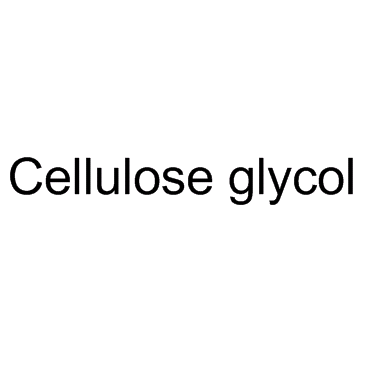Hydroxyethyl cellulose

Hydroxyethyl cellulose structure
|
Common Name | Hydroxyethyl cellulose | ||
|---|---|---|---|---|
| CAS Number | 9004-62-0 | Molecular Weight | 154.25100 | |
| Density | 0.75 g/mL at 25ºC(lit.) | Boiling Point | N/A | |
| Molecular Formula | C4H10O2S2 | Melting Point | 288-290ºC (dec.) | |
| MSDS | Chinese USA | Flash Point | N/A | |
Use of Hydroxyethyl celluloseHydroxyethyl cellulose is a non-ionic, water soluble, modified cellulose polymer used as a thickening agent for aqueous cosmetic and personal care formulations. |
| Name | Hydroxyethyl Cellulose |
|---|---|
| Synonym | More Synonyms |
| Description | Hydroxyethyl cellulose is a non-ionic, water soluble, modified cellulose polymer used as a thickening agent for aqueous cosmetic and personal care formulations. |
|---|---|
| Related Catalog | |
| In Vitro | Stabilization of graphene oxide in physiological solution is performed using hydroxyethyl cellulose to make the resultant nanohybrid suitable for targeted drug delivery purposes. Hydroxyethyl cellulose effectively stabilizes graphene oxid in electrolyte solutions and the mechanism of stabilization appears to be depended on hydroxyethyl cellulose content. Hydroxyethyl cellulose content in the nanohybrid plays an important role in final application to make it applicable either as a carrier for controllable drug release or as a folate-targeted drug carrier[1]. Hydroxyethyl cellulose shows superior cryoprotective effects on LDH during freeze thawing, and considerable lyoprotective effects during the freeze drying process. Annealing has limited influence on the stabilizing effect of hydroxyethyl cellulose. The extensive reconstitution times of the hydroxyethyl cellulose lyophilisates could be greatly improved by incorporation of the surfactant Tween 80 into the formulations prior to freeze drying[2]. |
| References |
| Density | 0.75 g/mL at 25ºC(lit.) |
|---|---|
| Melting Point | 288-290ºC (dec.) |
| Molecular Formula | C4H10O2S2 |
| Molecular Weight | 154.25100 |
| Exact Mass | 154.01200 |
| PSA | 91.06000 |
| LogP | 0.35240 |
| Storage condition | room temp |
| Stability | Stable. Incompatible with strong oxidizing agents, acid chlorides, acid anhydrides |
| Water Solubility | H2O: ≤5 wt. % at 20 °C |
CHEMICAL IDENTIFICATION
HEALTH HAZARD DATAACUTE TOXICITY DATA
|
| Personal Protective Equipment | Eyeshields;Gloves;type N95 (US);type P1 (EN143) respirator filter |
|---|---|
| Hazard Codes | T |
| Risk Phrases | R23/24/25 |
| Safety Phrases | 26-36-45-24/25-22 |
| RIDADR | NONH for all modes of transport |
| WGK Germany | 3 |
| RTECS | FJ5958000 |
| HS Code | 3912390000 |
| HS Code | 3912390000 |
|---|
|
Effects of different amine fluoride concentrations on enamel remineralization.
J. Dent. 40(9) , 750-5, (2012) The aim of this study was to investigate the effects of decreasing fluoride concentrations on repeated demineralizing challenges on human enamel.In 24 teeth, 3mm×3mm windows were prepared on the bucca... |
|
|
Disposable polyester-toner electrophoresis microchips for DNA analysis.
Analyst 137(11) , 2692-8, (2012) Microchip electrophoresis has become a powerful tool for DNA separation, offering all of the advantages typically associated with miniaturized techniques: high speed, high resolution, ease of automati... |
|
|
Effect of fluoride, lesion baseline severity and mineral distribution on lesion progression.
Caries Res. 46(1) , 23-30, (2012) The present study investigated the effects of fluoride (F) concentration, lesion baseline severity (ΔZ(base)) and mineral distribution on lesion progression. Artificial caries lesions were created usi... |
| MFCD00072770 |
| 2,2'-Disulfanediyldiethanol |
| EINECS 618-387-5 |

